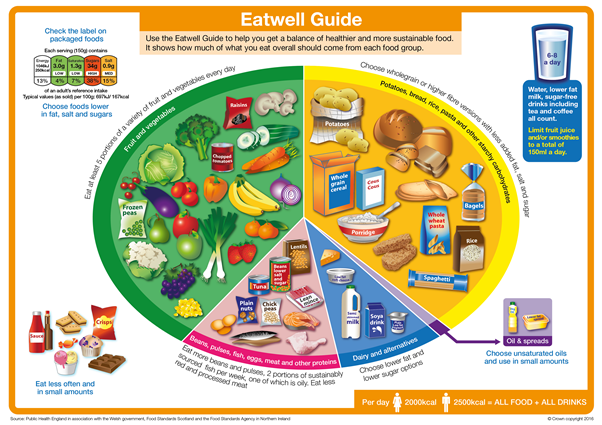What is the Eatwell Guide?
The Eatwell Guide helps us eat a healthy, balanced diet with plenty of fruit, vegetables and starchy carbohydrates plus some dairy, meat, fish, pulses and other kinds of protein. It replaced eatwell plate as the main tool showing you a healthy balanced diet. It no longer represents a ‘plate’ but still shows the proportions of the foods and drinks that make up a healthy diet. The proportions of food groups been updated to take into account the new dietary recommendations for more fibre and less sugar.
Use the Eatwell Guide to help you stay at a healthy weight, which will lower your risk of getting ill. It also has important advice about staying hydrated.
To view this information in British Sign Language, please go to the Public Health Scotland website: Eatwell Guide (BSL) | Translations (nhsinform.scot)

Although some of the proportions of the plate have slightly changed, the general principle is still the same: eat plenty of fruit, vegetables and plain starchy carbohydrates (particularly wholegrains), some dairy, meat, fish, pulses and other sources of protein, and consume foods which are high in fat, salt and sugar less often and in smaller amounts. The Eatwell Guide also provides information on hydration, calorie guidelines and front of pack nutrition labeling.
Is the Eatwell Guide for me?
The Eatwell Guide applies to most people regardless of weight, dietary restrictions/preferences or ethnic origin. However, it doesn’t apply to children under 2 because they have different nutritional needs. Between the ages of 2 and 5, children should gradually move to eating the same foods as the rest of the family, in the proportions shown on the Eatwell Guide. Anyone with special dietary requirements or medical needs might want to check with a registered dietitian on how to adapt the Eatwell Guide to meet their individual needs.
The development of the Eatwell Guide was led by Public Health England (PHE) in association with the Welsh Government, FSS and the Food Standards Agency in Northern Ireland.
Healthy eating tutorial
By the end of the tutorial, you’ll know what a healthy diet looks like, why it’s important, and what help is available to achieve it. There is also an optional assessment module and provided you pass you will receive a certificate.
Eatwell Guide Booklet
The Eatwell Guide shows the proportions in which different types of foods are needed to have a well-balanced and healthy diet.
Vitamins and minerals
Vitamins and minerals are essential nutrients that our body needs to work properly.
Sugar
Most of us need to cut down on the sugar we consume, it's low in nutritional value and shouldn't be part of a healthy diet.
Salt
Two thirds of us eat too much salt. Around 75% of salt we eat comes from everyday foods like bread, breakfast cereal and ready meals.
Fats
Too much fat, especially saturated fat, can increase the risk of heart disease.
The five food groups
A balanced diet is made up of the five food groups.